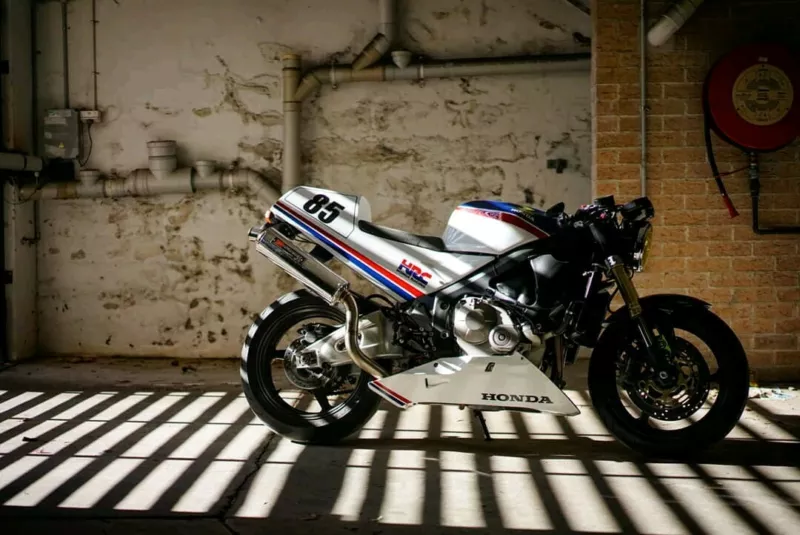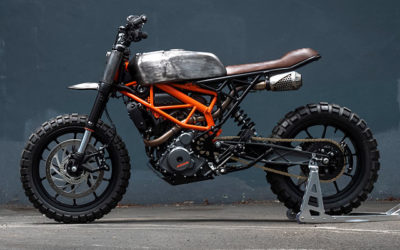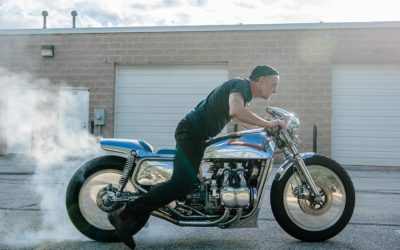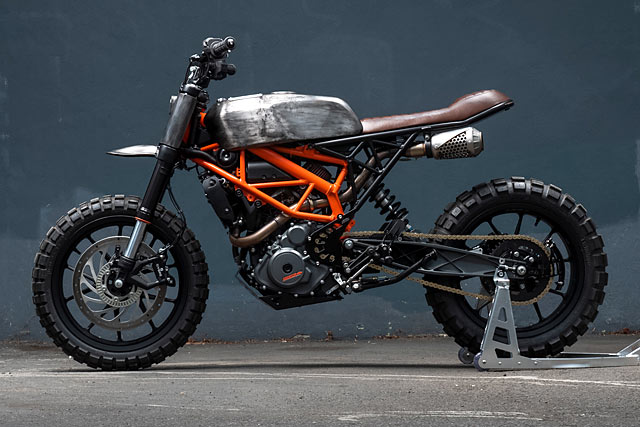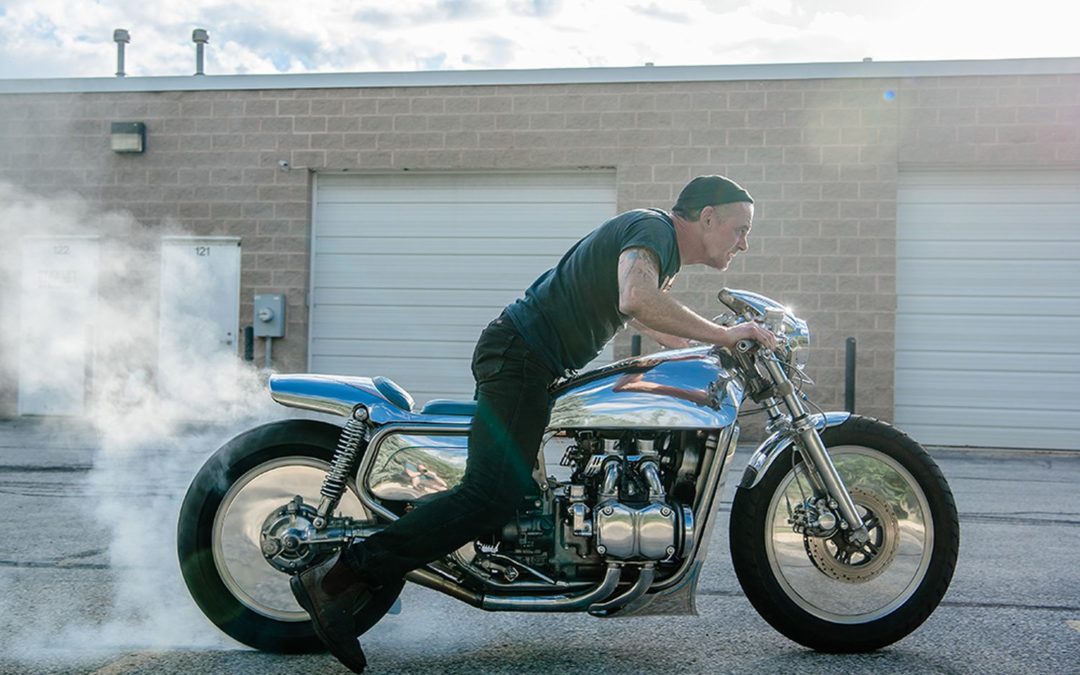It was a tough choice this week – choosing between a Honda CBR600RR that’s been given a cafe-racer makeover and a ride-on lawnmower that’s been given a 200cc KTM 2-stroke (yes, really) isn’t a decision we took lightly. Ultimately, the CBR won out because we didn’t want to be responsible for any overpowered lawn mower-related injuries.
Our chosen steed, an old Pipburn feature bike no less, is based on a 2006 Honda CBR600RR. The CBR600, or ‘Baby [Fire] Blade’ as it became known, transformed the once-popular supersport market by providing Honda reliability, a 15,000rpm redline and sweet handling. The CBR600 was so good in fact, that it was sold relatively unchanged for 14 years (2003-2017).

Honda CBR600RR Cafe Racer $7500
2006 Honda CBR600RR modified as a cafe racer. 35,000kms with new paint, bodywork and plenty of other custom bits. No rego listed. Located in Sydney, NSW.
The good bits
There are at least 15,000 reasons to like the CBR600 – most of them packaged into its tiny inline-four-cylinder. This engine, which was used in all Moto2 race bikes from launch in 2010 until Triumph took over last year, is as revvy as it is reliable. Being a Honda reliability is almost a given but the fact that they can make 115hp at 13,500rpm almost indefinitely is still mind-blowing. The fact you can pick up an un-modified example with 81,000kms is proof.
With the CBR600 built to bring Honda success in world supersport racing, the brakes, suspension, frame and swing-arm are all top-notch for their time. The fact that our feature bike has been stripped of its pointy, 2000’s bodywork for something with some 1980’s flavour isn’t going to change this race-bike DNA. When you consider traditional cafe racers of the 1960’s were bikes stripped of weight with a focus on performance, the use of a CBR600 seems like the perfect update to that recipe.
While wringing the neck of the 600cc engine will be fun, CBR600s are perhaps most well known for the way they handle. The UK’s Motorcycle News says the handling is “Razor Sharp”. I’m not sure what this means, but I have ridden CBR600s and can tell you that once you get used to the wrist-heavy seating position, you’re greeted by one of the most approachable sportbikes ever made.
The not so good bits
The CBR600’s main downfall is its lack of mid-range power, which means you’ll be chasing that 15,000rpm redline if you want to get anywhere quickly. Being a 2006 bike, ‘our’ CBR600 misses out on an update that gave more mid-range punch and slightly less weight that came in 2007.
Early CBR600’s had a bit of tendency to burn oil, so if you’re interested in one, check the oil level and listen out for any worrying noises (particularly on start-up) that could spell trouble. Cam chain tensioner and camshaft wear aren’t unheard of, particularly if they haven’t been regularly serviced. So after you’ve listened for noises on start-up, it’s worth checking the colour of the oil in the sight-glass and whether the bike has a service history.
We’re not sure why our feature bike was given its new look, but being a sportbike the possibility of a custom build being the result of fixing crash damage isn’t out of the question (see our second custom from Jamie Robinson and Roland Sands for proof). There’s nothing wrong with a once-crashed bike, as long as it’s been repaired to a high standard. So check for things like scratches on the forks and swing-arm that might indicate an un-manned trip down the road has taken place.
Below: For reference, here’s what a stock CBR600RR looks like. Hopefully you agree our feature bike’s a fairly large improvement over stock…
The customs
Retro by James Campbell

We cheated a bit this week, in so much as we started with a custom. The good thing about our laziness though is that you could actually ride our feature bike home! So, now that you know all about the CBR600 our build’s based on, let’s see what’s been done to it.
Somewhat reassuringly, the bloke selling the bike is also the one who built it. Even more reassuring is the fact that he’s got 15+ years of experience in modifying and maintaining planes, so you know the work’s going to be top-notch.
The most obvious of modifications is RRetro’s hand-made bodywork that harks back to 2-stroke race bikes of the 1980’s. The rear tail unit covers a handmade alloy subframe and the mix of CBR250RR tail light and lightweight carbon fibre and fibreglass construction keeps the old + new formula going.
The stock fairings have been shown the door with just a belly-pan remaining, which on closer inspection looks to be made from carbon fibre as well. Removing the original fairings meant a re-think of the headlight was needed. A single round headlight sits up front, with the stock CBR600 dash mounted close above. The tank shroud has also been customised to tie it in with the boxy tail unit’s 1980’s racer vibe and a fresh coat of paint with Rothmans styled graphics have been applied.
The engine is as Honda intended, except for the Yoshimura pipe that’s almost as long as it is cool. The big Yoshi is attached to the stock headers and looks a million times better than the stock under-seat unit. While engine mods are minimal, something tells me that the sound of four cylinders doing 15,000rpm through that exhaust wouldn’t need much improvement.
While the looks won’t be for everyone, the fact you can have a reliable, custom-built cafe racer that would hold its own on a twisty bit of road, a racetrack or stuck in traffic is worth the price of admission alone.

Dionysus by Jamie Robinson and Roland Sands

There’s nothing pretty about this custom from former motorcycle racer come YouTuber Jamie Robinson – but that’s pretty much as he planned it. This build kicked off after Robinson failed to execute a rather large mono on his once pristine 2007 CBR600RR. As you’d expect, flipping a bike end-for-end does it no favours and the resulting wreck sat in Robinson’s shed awaiting attention. When the time was right, Robinson called on his friend and prolific motorcycle builder Roland Sands to help him put the pieces back together.
Robinson wanted the CBR to go from a smashed-up dust collector in his garage to something “mean, loud and lots of fun – a cross between a Flat-Track, Supermoto and Supersport machine” – all while spending as little on parts as possible. As you can see from the pictures, he got what he asked for, albeit with a bit of a Mad Max, dystopian future vibe about it.
With access to Roland Sands and his workshop, Robinson cut off everything he wouldn’t need (most of it bent from his failed mono) and then set about piecing together the bare minimum needed to form a motorbike. While the clip-ons were thrown in the bin, replaced with highrise handlebars drilled into the stock triple clamps, the original CBR seat and rear sets were kept. This not only saved money but also retained the basic seating and footpeg position that worked so well in the CBR’s standard form.

The stock exhaust was also kept because it was there and not too broken. After the under-seat mufflers were chopped off it actually suited the look of the bike. The CBR600’s fuel tank shares space with the airbox on top of the engine and means the ‘tank’ you see is actually a plastic cover. This cover was cut up to allow airflow to the front of the airbox, which would normally be fed by a duct that sits between the standard bike’s headlights that were turned to dust in the crash.
What’s left of the bodywork has been rattle canned black and then scuffed-up, along with the paint on the engine, swingarm and frame, to complete the ready for the apocalypse look. The whole package is finished off with some relatively chunky adventure bike tyres that Robinson puts to good use by thrashing the CBR600 on pretty much every surface imaginable. This bike isn’t what you call pretty, but it looks like a whole lot of fun. See what we mean in the video below…

